A Novel Image Encryption Scheme Based on Self-Synchronous Chaotic Stream Cipher and Wavelet Transform
Abstract
:1. Introduction
2. Design and Implementation of Self-Synchronous Chaotic Stream Cipher
2.1. The Description of Four-Dimensional Discrete Chaotic System
2.2. Quantization and Performance Analysis of Discrete Chaotic Sequences
2.2.1. Binary Quantization Method
2.2.2. Multi-Scale Permutation Entropy Analysis
2.2.3. NIST-800-22 Test
2.3. The Design of Self-Synchronous Chaotic Stream Cipher
- The subkey is generated by function and with . Where and are the 0-1 binary sequence with length of 32 bits. The function is given as follows:
- The generated subkey is used as the state variable of the four-dimensional hyperchaotic system. The key stream , , and, with length of 8 bits are generated by hyperchaotic Equation (4) and a binary quantization operation with the purpose of parallel encryption.
- Ciphertext is generated by the Equation (6). At the same time, the will feedback to the function with the purpose of generating the next round subkey . Where is sequence assembly operation.
3. A Novel Image Encryption Scheme Based on Self-Synchronous Chaotic Stream Cipher
3.1. The Description of the Image Encryption Scheme
3.1.1. Discrete Wavelet Transform
3.1.2. Arnold Mapping
3.2. Security Analysis of Image Encryption Scheme
3.2.1. Histogram Analysis
3.2.2. Correlation Analysis of Adjacent Pixels
3.2.3. Peak Signal-To-Noise Ratio (PSNR) Analysis
3.2.4. Information Entropy Analysis
4. Discussion
Author Contributions
Acknowledgments
Conflicts of Interest
References
- Asikuzzaman, M.; Pickering, M.R. An overview of digital video watermarking. IEEE Trans. Circuit Syst. Video Technol. 2017, 27, 1–23. [Google Scholar] [CrossRef]
- Kengne, J. Coexistence of chaos with hyperchaos, period-3 doubling bifurcation, and transient chaos in the hyperchaotic oscillator with gyrators. Int. J. Bifurc. Chaos 2015, 25, 1550052. [Google Scholar] [CrossRef]
- Mahmoud, E.E.; Abood, F.S. A new nonlinear chaotic complex model and its complex antilag synchronization. Complexity 2017, 25, 3848953. [Google Scholar] [CrossRef]
- Wang, Q.X.; Yu, S.M.; Li, C.Q.; Lu, J.H.; Fang, X.L.; Guyeux, C.; Bahi, J.M. Theoretical design and FPGA-based implementation of higher-dimensional digital chaotic systems. IEEE Trans. Circuit Syst. I 2016, 63, 401–412. [Google Scholar] [CrossRef]
- Yang, Q.G.; Chen, G.R. A chaotic system with one saddle and two stable node-foci. Int. J. Bifurc. Chaos 2008, 18, 1393–1414. [Google Scholar] [CrossRef]
- Li, C.H.; Luo, G.C.; Qin, K.; Li, C.B. An image encryption scheme based on chaotic tent map. Nonlinear Dyn. 2017, 87, 127–133. [Google Scholar] [CrossRef]
- Cao, L.C.; Luo, Y.L.; Qiu, S.H.; Liu, J.X. A perturbation method to the tent map based on Lyapunov exponent and its application. Chin. Phys. B 2015, 24, 326–337. [Google Scholar] [CrossRef]
- Usama, M.; Khan, M.K.; Alghathbar, K.; Lee, C. Chaos-based secure satellite imagery cryptosystem. Comput. Math. Appl. 2010, 60, 326–337. [Google Scholar] [CrossRef]
- Zheng, Y.F.; Jin, J.X. A novel image encryption scheme based on Henon map and compound spatiotemporal chaos. Multimed. Tools Appl. 2015, 74, 7803–7820. [Google Scholar] [CrossRef]
- Ping, P.; Xu, F.; Mao, Y.C.; Wang, Z.J. Designing permutation-substitution image encryption networks with Henon map. Neurocomputing 2018, 283, 53–63. [Google Scholar] [CrossRef]
- Ye, G.D.; Huang, X.L. An efficient symmetric image encryption algorithm based on an intertwining logistic map. Neurocomputing 2017, 251, 45–53. [Google Scholar] [CrossRef]
- Haroun, M.F.; Gulliver, T.A. Real-time image encryption using a low-complexity discrete 3D dual chaotic cipher. Nonlinear Dyn. 2015, 82, 1523–1535. [Google Scholar] [CrossRef]
- Persohn, K.J.; Povinelli, R.J. Analyzing logistic map pseudorandom number generators for periodicity induced by finite precision floating-point representation. Chaos Soliton Fract. 2012, 45, 238–245. [Google Scholar] [CrossRef]
- Zheng, Y.B.; Song, Y.; Du, B.X.; Pan, J.; Ding, Q. A novel detection of periodic phenomena of binary chaotic sequences. Acta. Phys. Sin. Chin. Ed. 2012, 61, 230501. [Google Scholar]
- Khelifi, F. On the security of a stream cipher in reversible data hiding schemes operating in the encrypted domain. Signal Process. 2018, 143, 336–345. [Google Scholar] [CrossRef]
- Ullagaddi, V.; Hassan, F.; Devabhaktuni, V. Symmetric synchronous stream encryption using images. Signal Image Video Process. 2015, 9, 1–8. [Google Scholar] [CrossRef]
- Bucerzan, D.; Craciun, M.; Chis, V.; Ratiu, C. Stream ciphers analysis methods. Int. J. Comput. Commun. 2010, 5, 483–489. [Google Scholar] [CrossRef]
- Chen, G.R.; Lai, D.J. Making a dynamical system chaotic: Feedback control of Lyapunov exponents for discrete-time dynamical systems. IEEE Trans. Circuit Syst. I Fundam. Theory Appl. 2002, 44, 250–253. [Google Scholar] [CrossRef]
- Chen, G.R.; Lai, D.J. Feedback control of lyapunov exponents for discrete-time dynamical systems. Int. J. Bifurc. Chaos 1996, 6, 1341–1349. [Google Scholar] [CrossRef]
- Zhang, X.Y.; Liang, Y.T.; Zhou, J.Z.; Zang, Y. A novel bearing fault diagnosis model integrated permutation entropy, ensemble empirical mode decomposition and optimized SVM. Measurement 2015, 69, 164–179. [Google Scholar] [CrossRef]
- Bandt, C.; Pompe, B. Permutation entropy: A natural complexity measure for time series. Phys. Rev. Lett. 2002, 88, 174102. [Google Scholar] [CrossRef] [PubMed]
- Sun, K.H.; He, S.B.; Yin, L.Z.; Duo, L.K. Application of FuzzyEn algorithm to the analysis of complexity of chaotic sequence. Acta Phys. Sin. Chin. Ed. 2012, 61, 130507. [Google Scholar]
- Xu, W.; Ding, Q.; Zhang, X.G. Improving the complexity of chaotic sequence based on the PCA algorithm. J. Appl. Anal. Comput. 2015, 5, 262–272. [Google Scholar]
- Rukhin, A.; Soto, J.; Nechvatal, J.; Miles, S.; Barker, E. A statistical test suite for random and pseudorandom number generators for cryptographic applications. Appl. Phys. Lett. 2015, 22, 1645–1776. [Google Scholar]
- Soleymani, A.; Nordin, M.J.; Sundararajan, E. A chaotic cryptosystem for images based on Henon and Arnold cat map. Sci. World J. 2014, 2014, 536930. [Google Scholar] [CrossRef] [PubMed]
- Li, T.Y.; Yang, M.G.; Wu, J.; Jing, X. A novel image encryption algorithm based on a fractional-order hyperchaotic system and DNA computing. Complexity 2017, 2017, 9010251. [Google Scholar] [CrossRef]
- Yin, Q.; Wang, C.H. A new chaotic image encryption scheme using breadth-first search and dynamic diffusion. Int. J. Bifurc. Chaos 2018, 28, 1850047. [Google Scholar] [CrossRef]
- Zhu, C.X. A novel image encryption scheme based on improved hyperchaotic sequences. Opt. Commun. 2012, 285, 29–37. [Google Scholar] [CrossRef]
- Liu, H.J.; Kadir, A.; Sun, X.B. Chaos-based fast colour image encryption scheme with true random number keys from environmental noise. IET Image Process. 2017, 11, 324–332. [Google Scholar] [CrossRef]
- Liu, H.J.; Wang, X.Y. Color image encryption based on one-time keys and robust chaotic maps. Comput. Math. Appl. 2010, 59, 3320–3327. [Google Scholar] [CrossRef]
- Niyat, A.Y.; Moattar, M.H.; Torshiz, M.N. Color image encryption based on hybrid hyper-chaotic system and cellular automata. Opt. Laser Eng. 2017, 90, 225–237. [Google Scholar] [CrossRef]
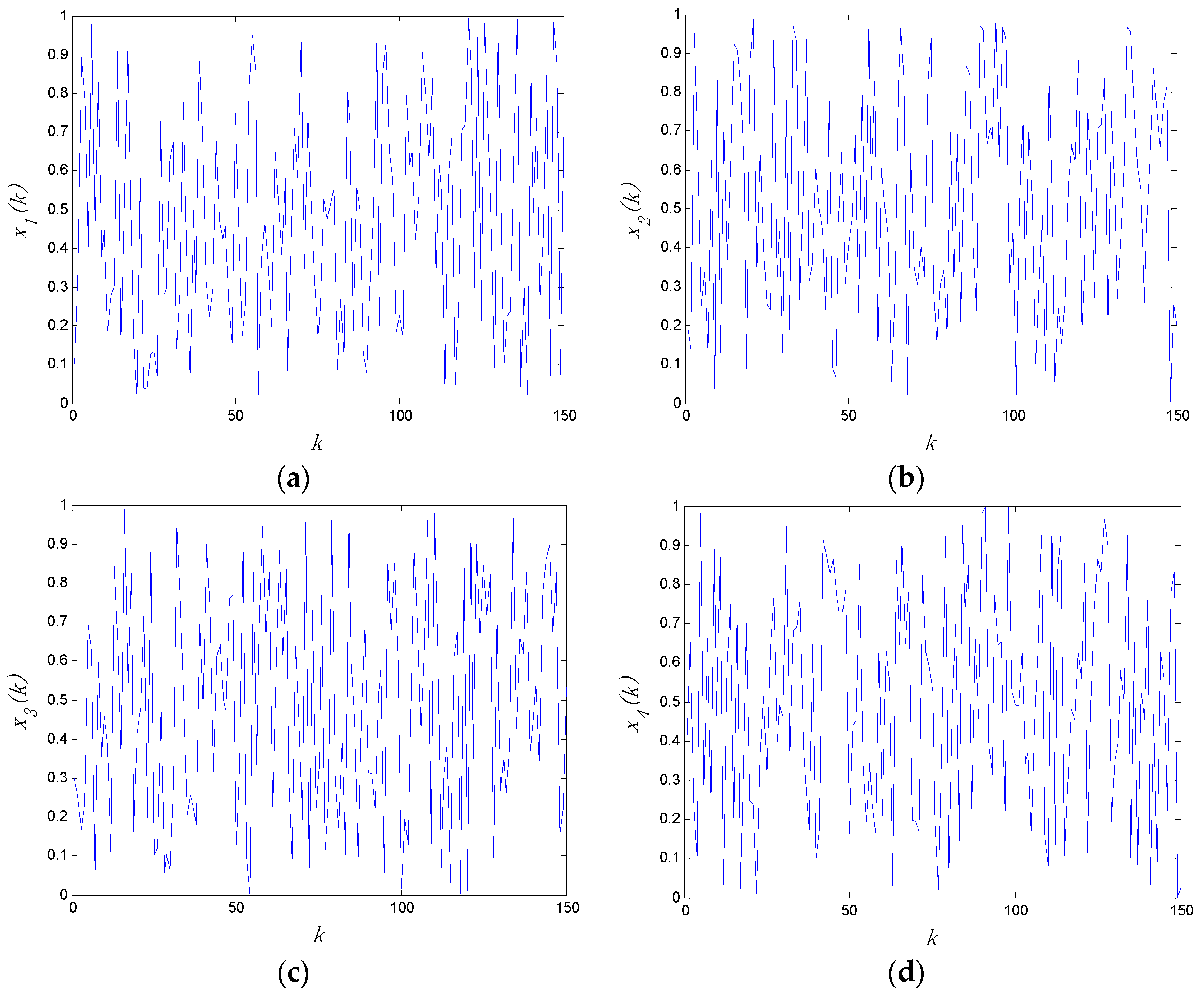
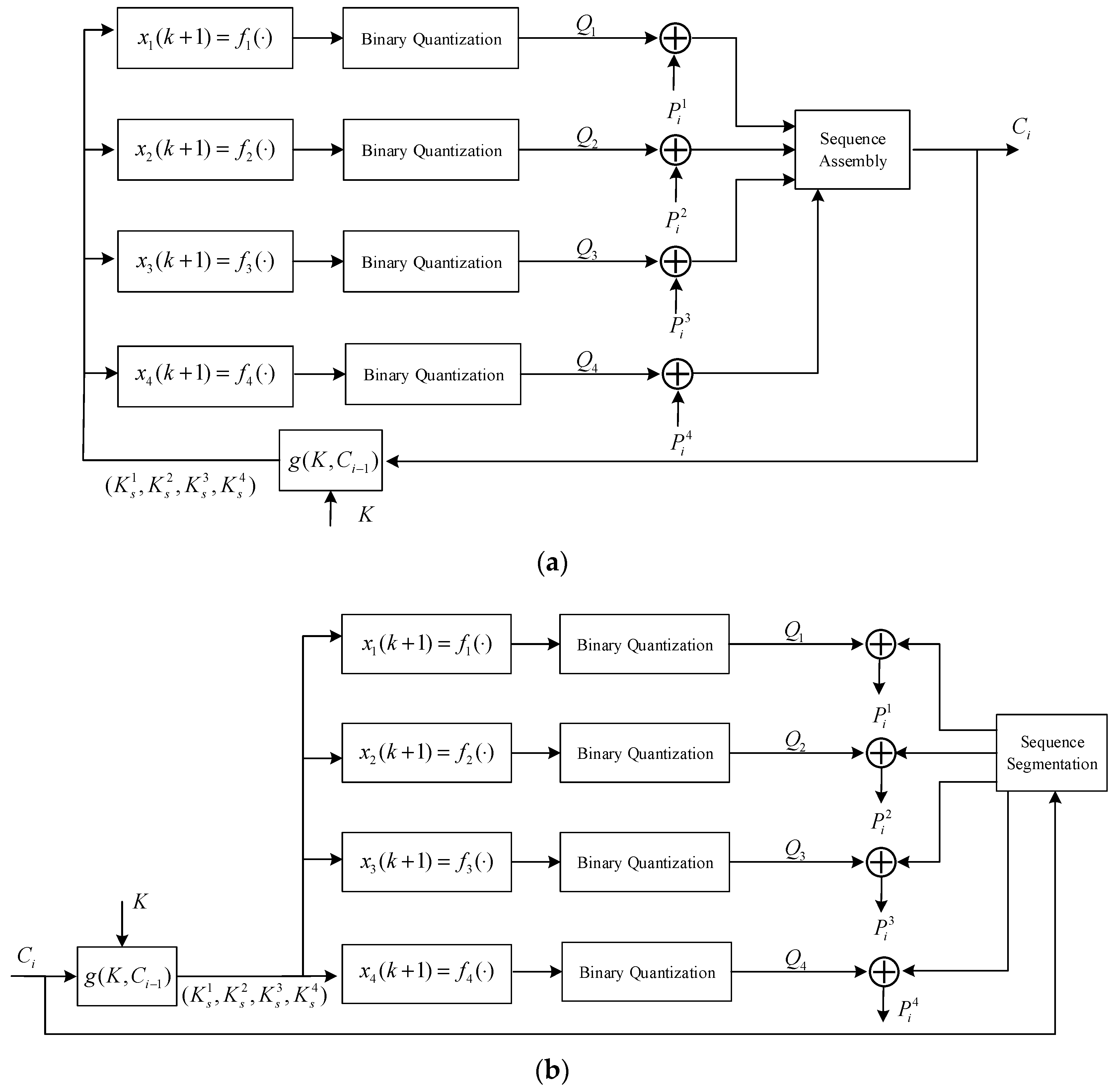
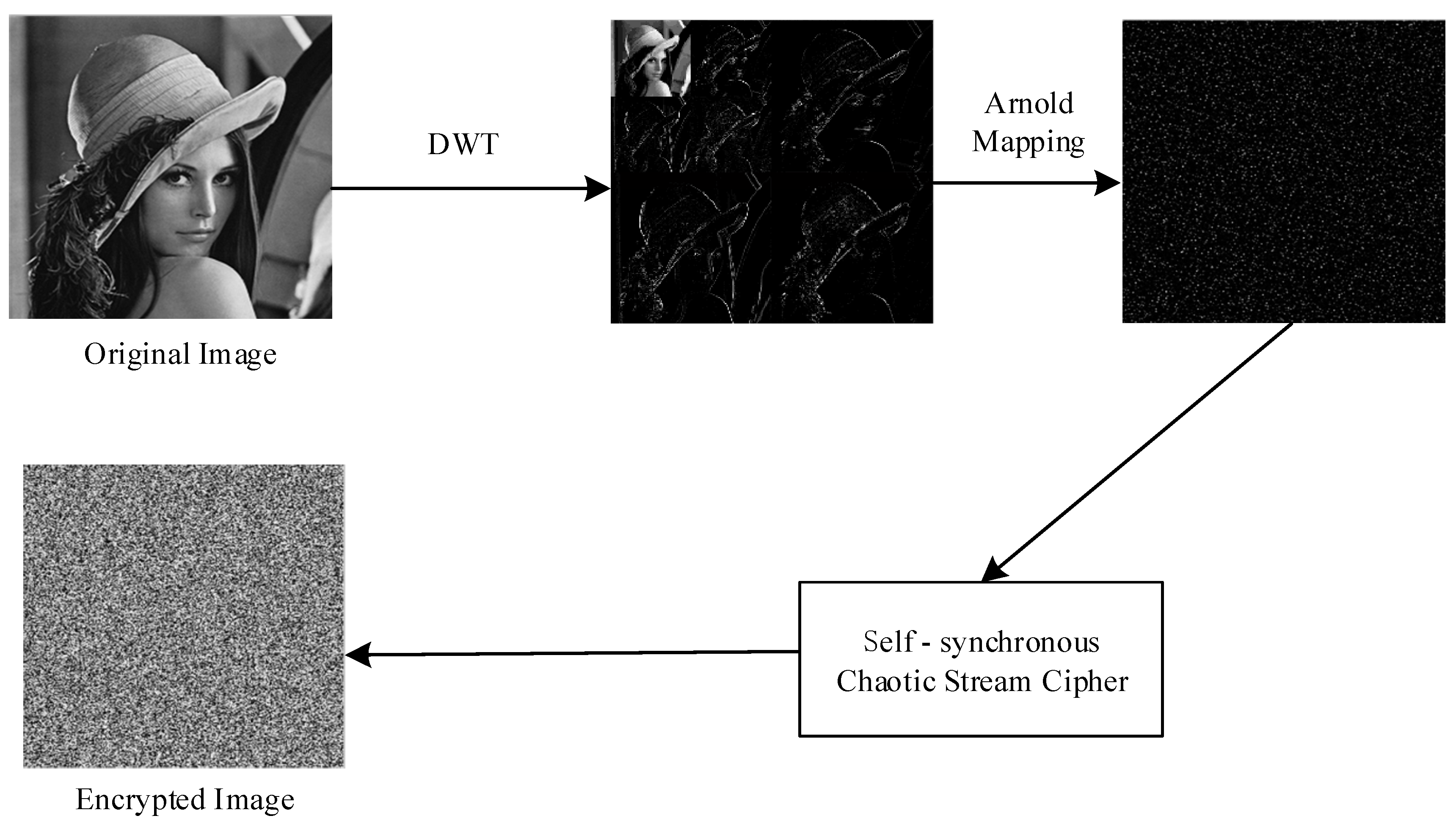
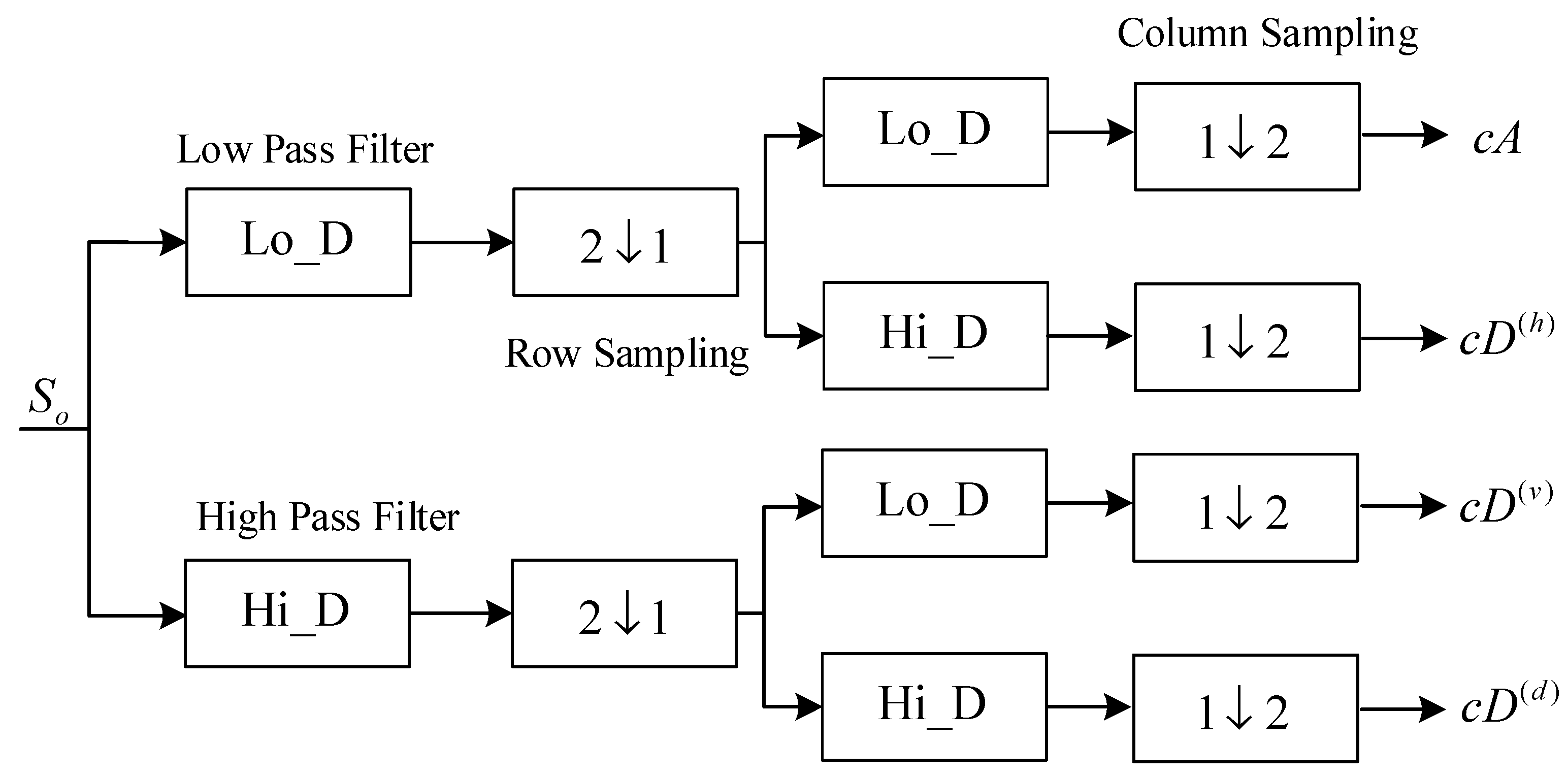
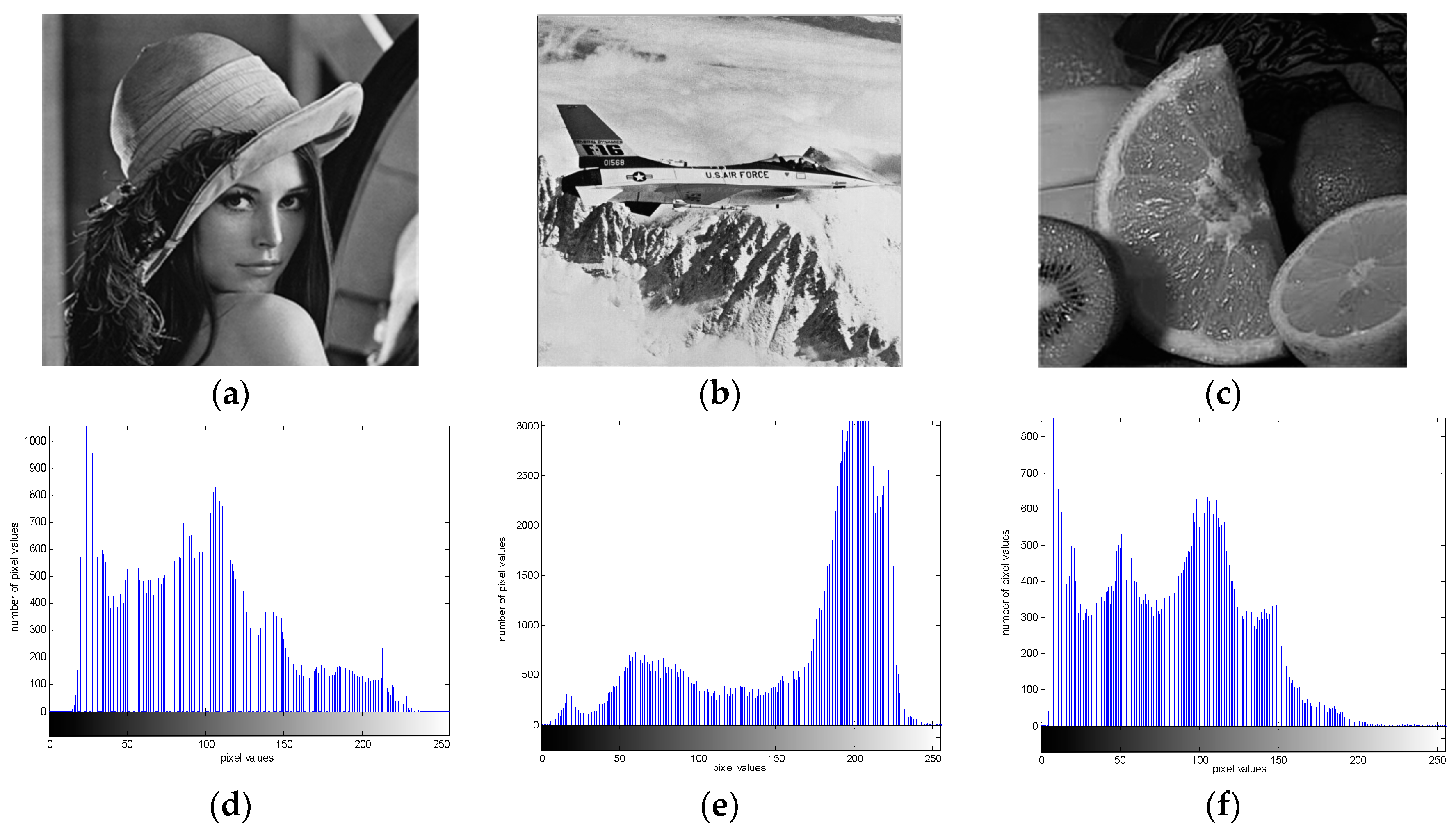


| Scale Factor | ||||
|---|---|---|---|---|
| 3 | 0.9201 | 0.9260 | 0.9177 | 0.9132 |
| 4 | 0.9366 | 0.9382 | 0.9449 | 0.9410 |
| 5 | 0.9548 | 0.9488 | 0.9567 | 0.9377 |
| 6 | 0.9590 | 0.9572 | 0.9585 | 0.9526 |
| 7 | 0.9552 | 0.9533 | 0.9704 | 0.9553 |
| Test Item | Result | ||||
|---|---|---|---|---|---|
| Approximate Entropy | 0.026853 | 0.013829 | 0.068205 | 0.034937 | Success |
| Block Frequency | 0.058378 | 0.870831 | 0.724584 | 0.297646 | Success |
| Cumulative Sums | 0.459642 | 0.069717 | 0.963210 | 0.328997 | Success |
| FFT | 0.358795 | 0.919848 | 0.081236 | 0.713570 | Success |
| Frequency | 0.435391 | 0.447255 | 0.888660 | 0.193601 | Success |
| Linear Complexity | 0.186537 | 0.203633 | 0.569565 | 0.232544 | Success |
| Longest Run | 0.359643 | 0.087189 | 0.789913 | 0.250387 | Success |
| Non-Overlapping Template | 0.348045 | 0.680967 | 0.106169 | 0.068529 | Success |
| Overlapping Template | 0.512834 | 0.063236 | 0.020689 | 0.490518 | Success |
| Random Excursions | 0.319514 | 0.181174 | 0.524622 | 0.304589 | Success |
| Random Excursions Variant | 0.579380 | 0.177934 | 0.108254 | 0.659874 | Success |
| Rank | 0.949536 | 0.648387 | 0.862457 | 0.648387 | Success |
| Runs | 0.340097 | 0.086469 | 0.041369 | 0.027231 | Success |
| Serial Test-1 | 0.407933 | 0.213432 | 0.648688 | 0.814738 | Success |
| Serial Test-2 | 0.462490 | 0.880617 | 0.584615 | 0.512974 | Success |
| Maurer’s Universal | 0.026152 | 0.538143 | 0.142680 | 0.600293 | Success |
| Direction | Horizontal | Vertical | Diagonal |
|---|---|---|---|
| Plain-image of Lena | 0.9577 | 0.9440 | 0.9126 |
| Cipher-image of Lena | −0.0082 | 0.0027 | 0.0030 |
| Plain-image of Airplane | 0.9147 | 0.9225 | 0.9109 |
| Cipher-image of Airplane | 0.0334 | −0.0285 | −0.0073 |
| Plain-image of Fruits | 0.9540 | 0.9497 | 0.9459 |
| Cipher-image of Fruits | −0.0273 | −0.0176 | −0.0026 |
© 2018 by the authors. Licensee MDPI, Basel, Switzerland. This article is an open access article distributed under the terms and conditions of the Creative Commons Attribution (CC BY) license (http://creativecommons.org/licenses/by/4.0/).
Share and Cite
Fan, C.; Ding, Q. A Novel Image Encryption Scheme Based on Self-Synchronous Chaotic Stream Cipher and Wavelet Transform. Entropy 2018, 20, 445. https://doi.org/10.3390/e20060445
Fan C, Ding Q. A Novel Image Encryption Scheme Based on Self-Synchronous Chaotic Stream Cipher and Wavelet Transform. Entropy. 2018; 20(6):445. https://doi.org/10.3390/e20060445
Chicago/Turabian StyleFan, Chunlei, and Qun Ding. 2018. "A Novel Image Encryption Scheme Based on Self-Synchronous Chaotic Stream Cipher and Wavelet Transform" Entropy 20, no. 6: 445. https://doi.org/10.3390/e20060445
APA StyleFan, C., & Ding, Q. (2018). A Novel Image Encryption Scheme Based on Self-Synchronous Chaotic Stream Cipher and Wavelet Transform. Entropy, 20(6), 445. https://doi.org/10.3390/e20060445





